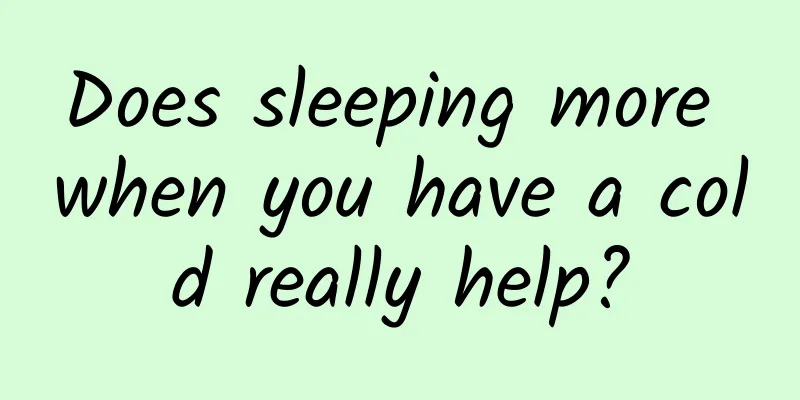Does sleeping more when you have a cold really help?

|
After being infected with the Omicron strain of the novel coronavirus, most of the symptoms are no different from those of a cold or flu. Everyday experience tells us that if you get more sleep when you have a cold, you will get better faster. Today's article explains the principle behind this experience. By understanding the principle, everyone can better cope with possible novel coronavirus infection. May everyone take good care of themselves. Written by | Cai Cai Sneezing, runny nose, stuffy nose, headache... You must have had a cold, right? The common cold is a viral infection of the upper respiratory tract. Symptoms include coughing, sneezing, runny nose, stuffy nose, headache, fever, etc. It has no obvious seasonality and is common all year round. [1] How common is it? According to the Centers for Disease Control and Prevention (CDC), adults catch colds two or three times a year on average, and children catch colds even more often (data source: There are many viruses that can cause colds, more than 200 in number, the most common of which is called rhinovirus. Since there is no effective medicine to treat these common cold viruses, common cold medicines can only relieve symptoms such as headaches, nasal congestion, and fever (Note: Some antiviral drugs can be used to treat influenza [2], but influenza viruses and common cold viruses are different and cannot be mixed). The most essential "treatment" still depends on the body's immune system to eliminate viral infections. People who are used to catching colds don't necessarily go to the doctor every time they catch a cold. They can try to rest, drink more water, and get more sleep. After a few days, the symptoms will naturally ease. You have probably heard people say, "If you have a cold, get more sleep," or "Sleep is the best cold medicine," right? These are all valuable experiences summed up from years of practice in dealing with colds. The scientific principles behind these experiences are also very interesting. For example, a research paper recently published in the Journal of Experimental Medicine (JEM) pointed out part of the scientific principle of "sleeping to cure colds": when people are asleep, their immune system is more capable of fighting viral infections [3]. Why is this so? First of all, we have to talk about the anti-virus pioneers T cells in our immune system. T cells are a general term for a type of blood cell. They are an important part of the immune system and can identify and eliminate pathogens. They work diligently every day and make great contributions to our health. When a person is infected with a virus, the killer team in the T cells can detect the virus-infected cells and eliminate them together with the cells and the virus, thereby limiting the spread of the virus and helping the human body to eventually clear the infection and defeat the virus [4]. In this anti-infection process, killer T cells fight in close combat and need to attach to virus-infected cells (that is, target cells) to make an effective response - just like the fierce "neck knee strike" in Muay Thai, first clamping the opponent's neck and then launching a fierce knee strike (it hurts so much just thinking about it...). The attachment between T cells and target cells, or the "hooking" action, depends on the integrin (β2-integrin) on the surface of T cells [5]. Only by grabbing the virus-infected target cells with the help of integrin can T cells make an effective knee strike, no, immune response. So, what is integrin? Integrins are a type of transmembrane protein widely expressed on the cell surface that helps cells communicate from the outside to the inside or from the inside to the outside [6]. Normally, when T cells are in a normal resting state and circulate in the blood, the integrins on the surface of T cells are also in an inactive state, just like putting your hands in your sleeves and taking it easy. After a viral infection occurs, the T cells sense the infection and become activated, and they will send signals from the inside of the cell to notify the integrins on the cell surface from the inside out. The integrins that receive the notification will change their structure, reach out from their sleeves, and grab the paired proteins called ICAM on the surface of the target cell, which will help the T cells attach to the target cell [5, 7-9], completing the immune process of "T cells notify integrins → integrins grab target cells → T cells launch an attack". A recent study by JEM found that the ability of T cells to activate integrins varies in different human states [3]. The researchers recruited volunteers and asked them to sleep or stay awake between 11pm and 7am, and then drew blood to measure the activation level of integrins. The results showed that the ability of T cells to activate integrins to pull the paired protein ICAM was significantly stronger when the same person was asleep than when awake. If the integrin activation ability was measured at 6am while sleeping and at 6pm while awake, the former was also significantly stronger than the latter. In other words, when a person is asleep, T cells can better notify integrins and grab target cells, and can more effectively launch attacks on target cells, thereby better eliminating viral infections. Why is this? When T cells float around in the body with the blood and sense a viral infection, the process of launching an attack will be affected by many factors, just like a person on a busy street who will receive various signals and will inevitably be overwhelmed and dazzled - some signals will tell the T cells "there is a viral infection here, come and destroy it", and some signals will distract the T cells and prevent them from concentrating on launching an attack. This JEM paper found that a series of molecules in our body, including adrenaline, norepinephrine, isoproterenol, prostaglandins, and adenosine, can distract T cells, so that T cells cannot concentrate on notifying integrins [3]. This is because these molecules can activate a type of receptor-type transmembrane protein called Gαs protein-coupled receptor (Gαs-coupled receptor) on the surface of T cells. When the Gαs protein-coupled receptor receives these molecules, the Gαs protein that partners with it will cause the level of a signaling molecule called cAMP inside the cell to increase. Previous studies have found that when the cAMP level increases, it will have a certain inhibitory effect on the immune response. For example, after prostaglandins activate the Gαs protein-coupled receptor, cAMP increases, which will inhibit the activity of T cells in the body [10-12]. Because the body's ability to produce a series of molecules such as adrenaline, prostaglandins, and adenosine is naturally weaker when sleeping, these molecules naturally interfere less with T cells. Therefore, for the same person, T cell integrin activation in the sleeping state is significantly stronger than in the awake state. However, if some of the above molecules are added to the blood sample in the sleeping state to activate the Gαs protein-coupled receptor, the integrin activation of T cells will be weakened again [3]. Therefore, when a person is asleep, the T cells have a stronger ability to clear viral infections. If you have a cold, you really need to sleep more to get better~ Author (Self) Introduction Cai Cai, a young scientific woman, is a lecturer at Harvard Medical School. References [1] Passioti, M., Maggina, P., Megremis, S. & Papadopoulos, NG The common cold: potential for future prevention or cure. Current allergy and asthma reports14, 413, doi:10.1007/s11882-013-0413-5 (2014). [2] Uyeki, TM A Step Forward in the Treatment of Influenza. The New England journal of medicine379, 975-977, doi:10.1056/NEJMe1810815 (2018). [3] Dimitrov, S. et al. Galphas-coupled receptor signaling and sleep regulate integrin activation of human antigen-specific T cells. J Exp Med216, 517-526, doi:10.1084/jem.20181169 (2019). [4] La Gruta, NL & Turner, SJ T cell mediated immunity to influenza: mechanisms of viral control. Trends in immunology35, 396-402, doi:10.1016/j.it.2014.06.004 (2014). [5] Evans, R. et al. Integrins in immunity. Journal of Cell Science122, 215-225, doi:10.1242/jcs.019117 (2009). [6] Bouvard, D., Pouwels, J., De Franceschi, N. & Ivaska, J. Integrin inactivators: balancing cellular functions in vitro and in vivo. Nature Reviews Molecular Cell Biology14, 430, doi:10.1038/nrm3599 [7] Ley, K., Laudanna, C., Cybulsky, MI & Nourshargh, S. Getting to the site of inflammation: the leukocyte adhesion cascade updated. Nature reviews. Immunology 7, 678-689, doi:10.1038/nri2156 (2007). [8] Fooksman, DR et al. Functional anatomy of T cell activation and synapse formation. Annual review of immunology 28, 79-105, doi:10.1146/annurev-immunol-030409-101308 (2010). [9] Long, EO ICAM-1: Getting a Grip on Leukocyte Adhesion. The Journal of Immunology 186, 5021-5023, doi:10.4049/jimmunol.1100646 (2011). [10] Leone, Robert D., Horton, Maureen R. & Powell, Jonathan D. Something in the Air: Hyperoxic Conditioning of the Tumor Microenvironment for Enhanced Immunotherapy. Cancer Cell 27, 435-436, doi: https://doi.org/10.1016/j.ccell.2015.03.014 (2015). [11] Oppenheimer-Marks, N., Kavanaugh, AF & Lipsky, PE Inhibition of the transendothelial migration of human T lymphocytes by prostaglandin E2. The Journal of Immunology 152, 5703-5713 (1994). [12] Mesri, M., Liversidge, J. & Forrester, JV Prostaglandin E2 and monoclonal antibody to lymphocyte function-associated antigen-1 differentially inhibit migration of T lymphocytes across microvascular retinal endothelial cells in rat. Immunology 88, 471-477 (1996). |
<<: Is a piece of porcelain really worth 700 million?
>>: Can cats understand other cats' names? Cats are smarter than you think!
Recommend
Yuexiu WeChat ordering mini program development, how much does it cost to develop a food ordering mini program?
Nowadays, many offline businesses are trying out ...
What should I do if my brand becomes “old”?
We often lament that the world has changed too fa...
Plastic bags can also be thrown into the recycling bin. Is that city friendly?
Have you ever paid attention to the plastics you ...
Cycling 50 kilometers without worrying about punctures? What is the difference between shared bikes and ordinary bikes?
Audit expert: Zhou Hongzhi Senior Experimentalist...
User Operation: AARRR Model for Products from 0 to 200,000 Users
Without further ado, the full article is structur...
Keep warm together? Blood routine test found "jelly blood", it turns out that red blood cells are also "afraid of cold"
After the Spring Festival, the cold wind blew in ...
Want a little patch of moss? Make your own!
For a dry area like Beijing, moss is not common. ...
Download the Baidu Cloud version of the high-end marketing logic: the quick transaction path
A brief introduction to the fast closing path res...
De Ge's Stock Discussion: Thirteen Short-term Hot Money Lessons
De Ge's Stock Discussion: Thirteen Short-term...
Keep product operation analysis!
1. Demand Background 1.1 Review of Competitive Pr...
"The Royal Anglican Knights" HD Japanese plug-in Chinese subtitles
Chinese name: Royal Anglican Knights Original tit...
The stainless steel kettle at home always has black stuff on it, what's going on? Is it poisonous?
I don’t know if you have ever encountered this si...
Volkswagen and Toyota are at war again, this time in India
According to the U.S. Automotive News, after Suzu...
Frog: I call myself "Gugua Gugua" to attract people, which is also a way to seek a mate.
I am Dong Dong Meow Talking animals are so fun! T...
The second generation of COVID-19 vaccine is here! Do you still need it after taking the first generation?
On December 27, the UAE Ministry of Health and Pr...


![Blocked Douyin account, forced to raise the commission of small shops [original price 8888]](/upload/images/67cc30e756fcc.webp)






